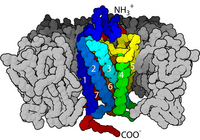
Photo from wikipedia
Significance NMDA receptors are glutamatergic channels whose activation controls the strength of excitatory synapses in the central nervous system. Agonist binding initiates a complex activation reaction that consists of a… Click to show full abstract
Significance NMDA receptors are glutamatergic channels whose activation controls the strength of excitatory synapses in the central nervous system. Agonist binding initiates a complex activation reaction that consists of a stepwise sequence of reversible isomerizations. In addition to previously identified steps in this series, which include agonist-induced closure of the ligand-binding lobes and the subsequent mechanical pulling by the ligand-binding domain on the gate-forming transmembrane helix, we identify a cross-subunit interaction that stabilizes open receptors and slows the rate of the current decay. Naturally occurring NMDA receptor variants lacking this interaction are pathogenic. NMDA receptors are excitatory channels with critical functions in the physiology of central synapses. Their activation reaction proceeds as a series of kinetically distinguishable, reversible steps, whose structural bases are currently under investigation. Very likely, the earliest steps include glutamate binding to glycine-bound receptors and subsequent constriction of the ligand-binding domain. Later, three short linkers transduce this movement to open the gate by mechanical pulling on transmembrane helices. Here, we used molecular and kinetic simulations and double-mutant cycle analyses to show that a direct chemical interaction between GluN1-I642 (on M3 helix) and GluN2A-L550 (on L1-M1 linker) stabilizes receptors after they have opened and thus represents one of the structural changes that occur late in the activation reaction. This native interaction extends the current decay, and its absence causes deficits in charge transfer by GluN1-I642L, a pathogenic human variant.
Journal Title: Proceedings of the National Academy of Sciences of the United States of America
Year Published: 2020
Link to full text (if available)
Share on Social Media: Sign Up to like & get
recommendations!